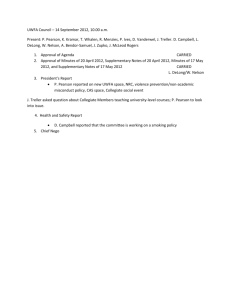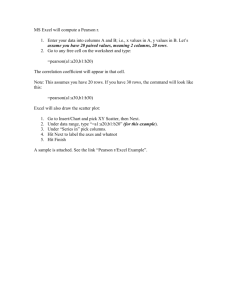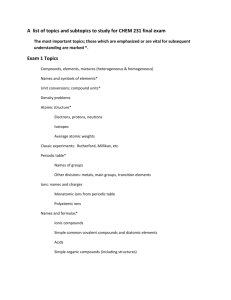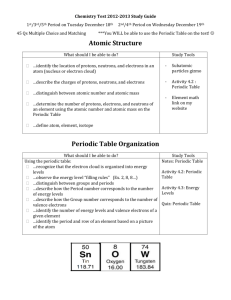Year 9 Chemical Sciences Program
advertisement
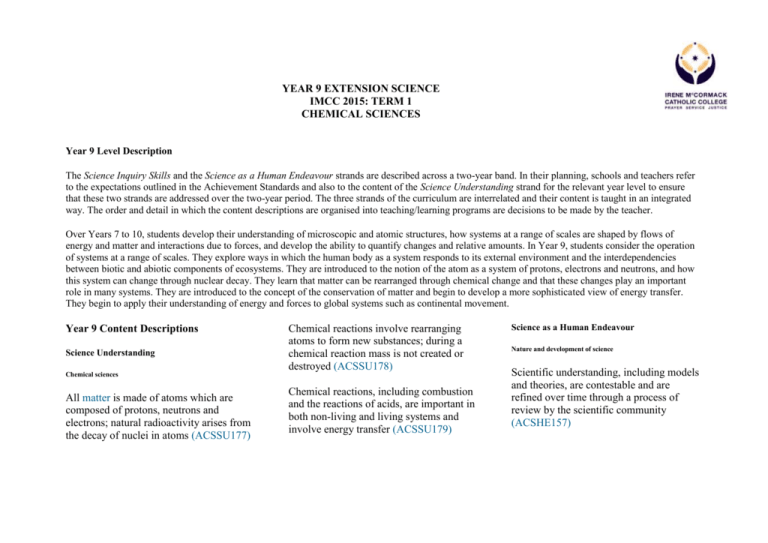
YEAR 9 EXTENSION SCIENCE IMCC 2015: TERM 1 CHEMICAL SCIENCES Year 9 Level Description The Science Inquiry Skills and the Science as a Human Endeavour strands are described across a two-year band. In their planning, schools and teachers refer to the expectations outlined in the Achievement Standards and also to the content of the Science Understanding strand for the relevant year level to ensure that these two strands are addressed over the two-year period. The three strands of the curriculum are interrelated and their content is taught in an integrated way. The order and detail in which the content descriptions are organised into teaching/learning programs are decisions to be made by the teacher. Over Years 7 to 10, students develop their understanding of microscopic and atomic structures, how systems at a range of scales are shaped by flows of energy and matter and interactions due to forces, and develop the ability to quantify changes and relative amounts. In Year 9, students consider the operation of systems at a range of scales. They explore ways in which the human body as a system responds to its external environment and the interdependencies between biotic and abiotic components of ecosystems. They are introduced to the notion of the atom as a system of protons, electrons and neutrons, and how this system can change through nuclear decay. They learn that matter can be rearranged through chemical change and that these changes play an important role in many systems. They are introduced to the concept of the conservation of matter and begin to develop a more sophisticated view of energy transfer. They begin to apply their understanding of energy and forces to global systems such as continental movement. Year 9 Content Descriptions Science Understanding Chemical sciences All matter is made of atoms which are composed of protons, neutrons and electrons; natural radioactivity arises from the decay of nuclei in atoms (ACSSU177) Chemical reactions involve rearranging atoms to form new substances; during a chemical reaction mass is not created or destroyed (ACSSU178) Chemical reactions, including combustion and the reactions of acids, are important in both non-living and living systems and involve energy transfer (ACSSU179) Science as a Human Endeavour Nature and development of science Scientific understanding, including models and theories, are contestable and are refined over time through a process of review by the scientific community (ACSHE157) Advances in scientific understanding often rely on developments in technology and technological advances are often linked to scientific discoveries (ACSHE158) Use and influence of science People can use scientific knowledge to evaluate whether they should accept claims, explanations or predictions (ACSHE160) Advances in science and emerging sciences and technologies can significantly affect people’s lives, including generating new career opportunities (ACSHE161) The values and needs of contemporary society can influence the focus of scientific research (ACSHE228) Science Inquiry Skills Questioning and predicting Formulate questions or hypotheses that can be investigated scientifically (ACSIS164) Planning and conducting Plan, select and use appropriate investigation methods, including field work and laboratory experimentation, to collect reliable data; assess risk and address ethical issues associated with these methods (ACSIS165) Select and use appropriate equipment, including digital technologies, to systematically and accurately collect and record data (ACSIS166) Evaluating Evaluate conclusions, including identifying sources of uncertainty and possible alternative explanations, and describe specific ways to improve the quality of the data (ACSIS171) Critically analyse the validity of information in secondary sources and evaluate the approaches used to solve problems (ACSIS172) Processing and analysing data and information Communicating Analyse patterns and trends in data, including describing relationships between variables and identifying inconsistencies (ACSIS169) Use knowledge of scientific concepts to draw conclusions that are consistent with evidence (ACSIS170) Communicate scientific ideas and information for a particular purpose, including constructing evidence-based arguments and using appropriate scientific language, conventions and representations (ACSIS174) Chemical Sciences Program Term 1 2015. Skills/content knowledge: Chemical Sciences Week 1 2nd Feb – 6th Feb Describe the structure of an atom and differentiate between atoms, molecules, elements and compounds. Using a periodic table, determine the different groups of metals and memorise 30 elements (and their symbols) of the PT. Calculate the atomic number, mass number and number of protons, neutrons and electrons of elements. Draw electron shell diagrams and use the electron configuration. Determine between cations and anions and describe how they form. Students write chemical formula and use it to write chemical reactions. Differentiate between the various acid reactions by determining their products and reactants and practically test the presence of different gases formed. Give examples of different reactions (endothermic, exothermic, photosynthesis, respiration & combustion reactions). Content Atoms Elements Molecules Compounds Periodic table Activities Resources and Experiments Assessment and Homework Pearson Science 9, Ch1.1 Make a model of some molecules using balloons to hang in class OR Use the molecule making model kits. Chemistry booklet 1 Element quiz sheet. Unit Review qs p.10 Pearson Text. Qs 1-16. Define atoms/molecules Revise the structure of the atom – protons, electrons, neutrons Define elements/compounds Give students a periodic table and ask students to highlight the first 20 elements of the periodic table and their symbol as well as Au, Ag, Pb, Cu, Sn, Zn, Ni, U, Fe, Hg. Periodic table shortcuts – Across (Periods – tell us how many shells). Vertical (Columns – tell us how many electrons in the outer shell). Charges of each group. Periodically, during the term, give students a Interactive periodic table http://www.learner.org/interactives/p eriodic/periodic_table.html Chemistry booklet 1 quiz to test the chemical names and symbols. 2/3 9th Feb – 20th Feb Atomic Nuclei Isotopes Atomic nuclei – atomic number/mass number. Students identify and calculate the atomic mass and number as well as the number of protons, electrons and protons. Electron Shells & electron configuration. Atomic structure sheet Pearson Activity Book 1.1 ‘atomic symbols’ Read pg 6 in Pearson Science text and ask students to write examples of the isotopes given. Show isotopes video http://www.youtube.com/watch?v=xjY5p1CDr8 Pearson Activity Book 1.2 ‘Isotopes’ Read pg 7 of Pearson text ‘Electron Shells’. Students read about ‘electron configuration’ pg 7 of Pearson Text. Students should know the configuration is 2:8:18:32. Get students to practice drawing electron shell diagrams (practice the elements they’ve learnt week 1 first) Students must also write the electron configuration next to their drawings. Briefly discuss valence electrons and get students to identify the amount of valence electrons from their diagrams. (Will be revisited). Pearson Text Chapter 1.2 Formula writing and ions booklet Unit review 1.2 p. 18 Pearson Text qs 1 - Ions Formation of ions Writing Chemical formula 4 23rd Feb – 27th Feb Valence Electrons and Bonding (Ionic, Students read pg 13/14 from textbook about atoms and ions and the formation of cations and anions. Define ions and compare to an atom. Students define cation and anion Explain to students how cations and anions are formed, by the losing/gaining of electrons. Students can draw an atom/ion electron shell diagram to demonstrate the loss/gain of electrons. Give the students a valency table/table of common ions. Practical activity 1.2 p. 19/20 Pearson Text. Pearson Activity Book 1.4 ‘Electron Configurations of ions’ Pearson Activity 1.5 Book ‘Atoms and ions crossword’ Revising ions worksheet (additional ion sheets can be found in the above booklets) Chapter 1.2 Ions Pearson science Text pg 13. Pearson Website – extra activity sheets – atoms & ionic compounds (Student resources) Define ionic compounds – give students examples of common ionic compounds (p. 14/15 Pearson Text) Students practice writing formula using the Formula writing sheet practice booklets. Chemistry test 1 revision booklet Writing ionic formulas (p. 15 textbook) Test 1 revision Link the concept of Valence electrons to ionic and covalent bonds. Practical Experiment p 1.2 ‘Making ionic compounds’ & ‘Detecting ions Topic test 1: Period table & ionic formula writing test. Students will be able to have a valency table/periodic table for the test. Unit review questions 2.1 p.44 q 1-14 & 16 Covalent) Ionic Bonding & ions in solutions Metals, nonmetals and metalloids 5/6 3rd Mar – 13th Mar Acids & Bases Compare and contrast ionic and covalent bonds – briefly Ionic bonding – characteristics (p.15 Pearson 9 text) Ions and solutions (recrystalisation & electrical flow) by indirect observation’ p 19/20 of Pearson text. Using p. 38 in their Textbooks, students colour their own periodic tables to identify the metals, non-metals and metalloids. Use p. 39 from the textbook to identify the properties/uses of metals Use p. 42 from the textbook to identify the properties/uses of non-metals Compare alloys and metalloids. Pearson Science text chapter 2.1 p. 38. Practical Activities 2.1 ‘Making Steel Stronger’ & ‘Making Oxygen’ p.4445 of Pearson Science Text. Pearson Activity Book Activity 2.1 ‘Comparing alloys’ &’Changing the strength’ Pearson Science 10 text Chapter 4.3 Pearson Science Text Chapter 2.3 p.56 Hand out Chemical formula sheet. Acids and bases worksheet Practical experiment – Testing the pH of various solutions. Practical experiment – Litmus paper (red/blue) to test various solutions to see if they are an acid/base. Practical experiments p. 62 – 63. ‘Red cabbage indicator’, ‘Garden eggs’ & ‘pH column’. Students use the chapter to determine what an acid and a base are. Students list the properties/uses of acids and look at the strength of acids. Students should be able to say that the strength of an acid is dependant on the amount of hydrogen ions released. Students list the properties/uses of bases/alkalis. Students investigate the pH of solutions and use a pH scale to determine pH of solutions. Students should be aware of the different indicators that can be used to test solutions (table 2.3.6 p. 60). Students should use pH indicator and litmus Unit review questions p. 61 q 1- 13 paper to test solution 7/8 16th Mar – 27th Mar Types of reactions - Endothermic /exothermic - Combustion reactions - Corrosion reactions - Writing chemical equations Acid reactions - Acid/Bases - Acid/metals - Acid/Carbon Conservation of mass: During a chemical reaction mass is not created or destroyed. Students define reactants/products. Write an acid reaction on the board and students should label the reactants and products of that reaction. Write chemical equations – using steps on p. 69. - Examine examples of the different type of reactions and model how to write a chemical equation for each. - Balance equations for above reactions (will be useful for acid reactions). - Revise how to write chemical formula. Students learn how to write chemical formula (p. 69 of text). Acid/metal reactions – examples & equations Acid/base reactions (neutralisation) – examples & equations Acid/carbonate reactions – examples & equations Pearson Science Chapter 3.1 p. 68 Practical experiment 3.1 p 74 ‘Conservation of mass’ Unit review qs 73 qs 1 - 15 Spontaneous Exothermic Reaction Unlike the rest of the listed experiments, you can use this one to demonstrate how quickly and vigorously exothermic reactions may occur. Use 3 grams of potassium magnate and use a spatula to make a hollow in the middle of it. Then, pour about 1 cubed centimetre of glycerol in the hollow. After a few seconds, the compound will begin to give off steam and spontaneously burst into flames, leaving a black, ashy residue behind it. Be sure to conduct this experiment on a heatproof mat. Pearson Textbook Chapter 3.2 p. 77 Acid reactions practical booklet Acid reactions summary sheet Practical experiments: Pop Test, Unit review 3.2 p. 82 qs 1-9 ates Students need to identify the products and reactants of each equation, write the word equation and the chemical equation (balancing equation not necessary – only if you wish to extend students). Balancing equation for each type of reaction 9 30th Mar – 2nd Apr Additional work Neutralisation reaction & limewater Practical test: Acid tests. reactions. Practical experiment p.84 ‘Evaluating antacids’ Pearson Activity book 3.3 ‘Sulfuric Acid’ Pearson Activity book 3.4 ‘Acid rain’ Topic test Test revision Chemistry test 2 revision booklet Revision sheet Topic test Reactions of life - Photosynthe sis - Respiration Define photosynthesis & give the photosynthesis equation Identify the raw materials used in photosynthesis Define respiration and give the respiration equation Compare (by creating a venn diagram/table) respiration in humans and plants. Compare (by creating a venn diagram/table) respiration and photosynthesis. Pearson Science Ch. 3.3 p.85 Pearson Activity Book 3.5 ‘Light and dark reactions’ Pearson Activity book 3.6 ‘Rate of photosynthesis’ Pearson Activity book 3.7 ‘Anaerobic respiration’ Pearson Activity book 3.8 ‘Literacy review’ Practical experiment 3.3 p. 91/92 Unit review 3.3 p. 112 ASSESSMENT TYPE Topic Test Practical Test Topic Test Assessment Outline TITLE Chemistry topic test 1. Acids practical assessment Chemistry topic test 2 WEIGHTING 5% 5% 10%

